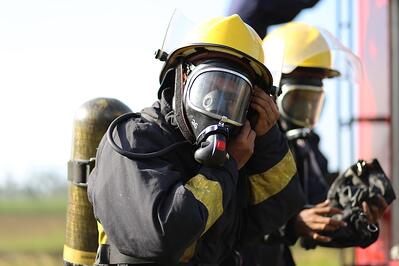 Continuous improvement and training are of paramount importance in the emergency services, where human error could result in fatalities. Mobile live broadcasting can give on-the-job training and support to both new recruits and on-going career development in the frontline of the emergency services. Trainees can wear the portable high-definition cameras or mount HD cameras on drones. Both cameras can broadcast live feeds with high quality image and sound transmission. The live, encrypted broadcasting allows the remote trainer(s) to advise and provide training and guidance in the field.
Continuous improvement and training are of paramount importance in the emergency services, where human error could result in fatalities. Mobile live broadcasting can give on-the-job training and support to both new recruits and on-going career development in the frontline of the emergency services. Trainees can wear the portable high-definition cameras or mount HD cameras on drones. Both cameras can broadcast live feeds with high quality image and sound transmission. The live, encrypted broadcasting allows the remote trainer(s) to advise and provide training and guidance in the field.
Payback on Investment
The payback for the investment in broadcasting equipment is very quick, as the trainers are able to watch multiple new recruits or trainees at once. The trainers can see live, real-time, high quality video with sound. They are able to see real-time interactions as if they were there too. The trainees can have on-the-job training follow up and support, during or after being monitored. As it’s real-time, the trainer can use in-ear headphones to feedback immediately or can summon extra help on the trainees behalf, if things get out of hand.
This application of technology in public services creates opportunities, which would normally be cost prohibitive. It is less feasible, to spend multiple days with just one recruit, while they start their on-location duties. Being able to support multiple staff in the field from one remote location, makes enhanced on-the-job training possible. The trainer can literally watch over many shoulders and listen in to conversations and events. They can intervene when needed, but speaker to the trainee on their headset either as and when events unfold or as they are reviewed.
This practise is also investing in long-term improvement for the department, as the footage, based on live experiences, can be used to train all new recruits with valuable interactions, summarised and in easy-to-learn formats.
If the tools and training help saves lives of the emergency services or the public, then payback becomes invaluable.
Ambulance and first response staff training
Mobile live broadcasting can vastly improve on-the-job training and the safety of our emergency services in the field. Ambulance staff would be able to get advice from surgeons or senior medical staff, whilst en route to the hospital. Even deciding whether the ambulance needs to go to a specialist hospital or the nearest treatment centre can be assessed remotely by hospital staff who can remotely evaluating the patients condition.
The golden time period extends, as paramedics are able to start preparatory treatment earlier whilst under remote supervision. Remote staff would learn in situ, whilst being coached by hospital staff. This is the safest and most cost effective way of continually learning remotely and on location. It has the added benefit of ensuring that no counter-productive treatments are done before hospital treatment. Monitoring the patient’s condition en route to the hospital can also aide the hospital staff’s preparation.
Police and security staff training
High adrenaline situations involving confrontations with armed assailants are critical for all staff involved. These situations are rare, but could leave lasting impact on all involved. It would be preferable to have the option for guidance in these situations and improve armed responses. It is possible to view a situation from a HD camera drone or portable camera and can help HQ assess the danger level. HQ can support and provide backup, whilst monitoring the situation as it unfolds.
All HD video evidence can optionally be recorded for future training purposes. This can feed into general training, using real-life examples. Analysis of the videos and responses can help develop protocols and frameworks for continuous improvement of all staff.
Fireman training
Firemen risk their lives with every burning building they enter. Any training and additional safety measures to reduce risk should be considered.
Live video streaming could help guide firemen to the scene or to safety when visibility is low. There are several ways to do this:
- Drones equipped with thermal imaging cameras can broadcast live to the fire team, around the incident vicinity, providing normally inaccessible feedback and indicating hot spots and danger zones to the staff coordinators on the ground.
- Thermal imagery videos broadcast via a drone can also be used to identify people within the building who are trapped or in danger.
- With new “x-ray vision” helmet screens, fire fighters can see outline views of their crew and their surroundings. This vastly enhances individual orientation in smoky and low-visibility environments. They could link up the AI cameras to live streaming broadcasters, in order to give command centres (on-site or remote) live, encrypted views of the crew and their environment at all times.
They can also use drones to film the crowd if they suspect arson, so that they can identify any known arsonists from the crowd. Using facial recognition on the drone live broadcast, speeds up recognition of arsonists from the police database of suspects and known arsonists and would enable arrests at the scene. The live footage in HD can be analysed by facial recognition tools in the command center, without any delay.



